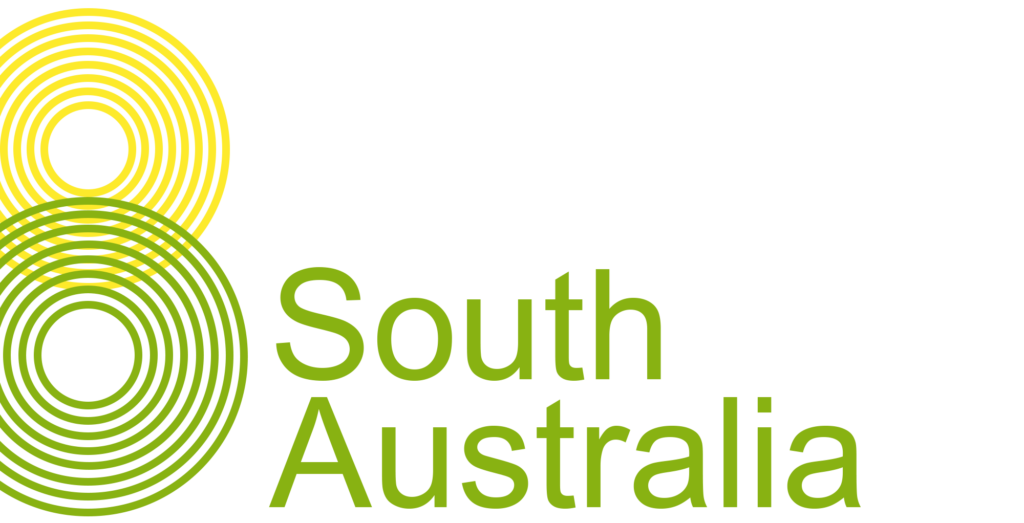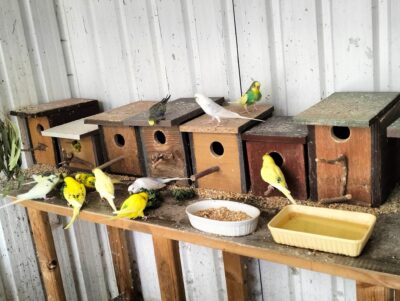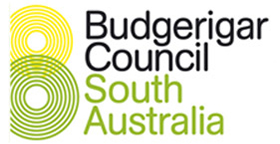
Budgerigar Nutrition & Feeding Exhibition Budgerigars
To achieve the best results, fanciers have different options for feeding their budgerigars, depending on their available resources and time. Nonetheless, those who are systematic and detail-oriented usually achieve the most success. Both fresh food and bespoke feeding systems can yield equally good results. Establishing a regular feeding schedule is needed, and mimicking the feeding patterns of wild budgerigars can benefit the health, well being and vitality of aviary budgies.
Aviary budgerigars still retain the flock patterns of their wild ancestors and thrive on feeding activities that involve the whole flock. Providing large feeding trays, interesting seeding grasses, and eucalyptus baths invigorate the flock and satisfy their instinctual needs, not just their hunger. Happier birds promote better physical wellbeing.
Soaking seed techniques can be harmful to aviary budgerigars. When you provide trays of fresh bread soaked in nutritional additives as part of the feeding routine, budgies easily accept them. However, fanciers must use soak seed with care and remove it before it goes ‘stale’. Cleanliness and hygiene are crucial to a successful feeding system.
The Requirement for Clean, Fresh Seed
In the wild, budgerigars select the most nutritious seeds, such as those that have recently fallen or those at the top of the seedling grass.  In the aviary, they don’t have this choice, so fresh and clean seed is crucial for a successful breeding season and the birds’ overall health. It cannot be overstated that fresh, clean food is essential. The next step is to protect the food from contamination during storage. Spoiled seed is the most common cause of poor breeding performance and recurrent illness in the budgerigar aviary. It is impossible to cure illnesses and poor breeding results when “bad feed” is the underlying cause. Food cleansers can be used to keep the food fresh and clean by protecting it from mould, yeast, and other harmful agents.
In the aviary, they don’t have this choice, so fresh and clean seed is crucial for a successful breeding season and the birds’ overall health. It cannot be overstated that fresh, clean food is essential. The next step is to protect the food from contamination during storage. Spoiled seed is the most common cause of poor breeding performance and recurrent illness in the budgerigar aviary. It is impossible to cure illnesses and poor breeding results when “bad feed” is the underlying cause. Food cleansers can be used to keep the food fresh and clean by protecting it from mould, yeast, and other harmful agents.
There are many reasons why the seed we feed our budgies can be poor quality. It can be old, dirty, poorly stored, seed that fails to sprout, or has a high moisture content. There are four ways to ensure the feed is free of harmful bacteria, fungus, or insecticides. The best food smells sweet and fresh, has low moisture content, and sprouts cleanly.
Signs of Contaminated Seed
Culture testing for fungus and bacteria is the best test for any sort of grain. Testing new feed on a selection of birds is crucial, as the observant fancier will notice changes in the flock’s health after feeding poor-quality feed. Veterinarians suggest to scrape clean the floor and remove all additives (grit, sand, etc.) immediately prior to testing the new feed. Within 24 hours, the droppings will turn large, dark green and runny; green stains may appear around dirty vents within three days; the birds become depressed and fluffed up, and the noise level within the aviary drops noticeably; the down feathers disappear from the droppings, and the eyes become dull. Within three weeks, other diseases may appear that recur and fail to respond to the appropriate treatment. These are all signs of poor quality seed being provided to the birds.
Clean Water
Equally important is clean water in budgerigar nutrition. Budgerigars have evolved in the dry conditions of outback Australia and are therefore particularly susceptible to water-related illnesses. Clean water is critical for good health. Without clean water, the battle against illness is already lost. The water dish is the perfect place from which illnesses can flourish, and spread to other members of the flock. The sludge accumulating in the edges and corners of the drinkers is a particularly potent source of dangerous germs. Feeding parents drink large amounts of water, and unclean water exposes their babies to great danger. Water cleansers are necessary for budgerigar aviaries and are the best means of keeping the water clean and containers sludge-free.
Energy and Protein for Budgerigars
The nutrition and energy requirements of captive budgerigars can be far greater than those of their wild counterparts. One example of this is fledging the nest. The modern exhibition budgerigar takes six weeks to fledge, compared with four weeks for their wild counterparts. To produce healthy young birds, breeders must provide extra energy and protein in their diet. High-quality food supplements are the best way to maximize energy and balance protein for breeding budgerigars. Soaking seed for instant energy can be beneficial, but it can also be dangerous if not done correctly. Groats and sunflower seeds are the best seeds for soaking because they are high in energy, lysine, and methionine.
Balancing essential amino acids in the seed mix is necessary for good growth rates and breeding results. Lysine is the most difficult amino acid to balance, and a protein-enhanced seed mix fed to breeding birds can benefit the entire flock. Wild budgies balance protein by selecting many seed and herb types and attacking the bark of eucalypts in search of lysine. In contrast, the modern-day, big-bodied, and heavy-feathered budgerigars need protein additives.
Trace Elements & Minerals
 Minerals and trace elements are often neglected in budgerigar nutrition. Seeds are a poor source of these nutrients, and regular grits only provide calcium, not other important minerals and trace elements. Wild budgies forage dirt and river edges to obtain these nutrients. Shell grit provides calcium but not enough minerals and trace elements. Cuttlefish bone is a good source of calcium but lacks other minerals. Soil contains minerals such as iron, magnesium, and other elements that budgerigars crave when feeding their young, but it can also be a source of bacterial and fungal infections that can be harmful to budgerigars.
Minerals and trace elements are often neglected in budgerigar nutrition. Seeds are a poor source of these nutrients, and regular grits only provide calcium, not other important minerals and trace elements. Wild budgies forage dirt and river edges to obtain these nutrients. Shell grit provides calcium but not enough minerals and trace elements. Cuttlefish bone is a good source of calcium but lacks other minerals. Soil contains minerals such as iron, magnesium, and other elements that budgerigars crave when feeding their young, but it can also be a source of bacterial and fungal infections that can be harmful to budgerigars.
Laying hens need more than twice the calcium of aviary birds, and a concentrated mineral supplement is the safest way to provide it. Too much shell grit can lead to gizzard obstruction and other health issues. Egg binding, cloacal prolapse, leg problems in babies, or poor egg quality may be a result of a low level of calcium in the diet or poor calcium absorption. Conversely, wet grit can promote harmful bacterial growth and contamination, leading to enteritis, wet nests, and poor breeding performance.
Depletion of minerals occurs mostly when hens are laying eggs and when parents are heavily feeding their young. Depleted birds become agitated and may overeat grit or Cuttlefish bone, leading to vomiting and, in rare cases, death. The most important trace elements for breeding budgerigars are iodine, iron, copper, and zinc. Deficiencies in any of these trace elements can decrease breeding performance. Iodine, in particular, is important for breeding, and supplementation is best given in the water or soft food mix during the breeding season.
Vitamins Key to Successful Breeding & Budgerigar Nutrition
The modern budgerigar is larger with greater feather mass, slower growth, and requires more energy and nutrients for development. Without proper vitamin and mineral levels, breeding birds become more prone to illness and their chicks may weaken. Although budgies can survive on grain and grit, they require more vitamins to reach the necessary level of health to withstand breeding pressures. Nowadays, vitamins are provided in soft food or water mixes, with Thiamine being especially important for reducing stress and accelerating recovery in ill birds.
Vitamin A is crucial for promoting appetite, good digestion, and increasing resistance to infection and parasites. Unfortunately, it is lacking in seeds. Signs of a deficiency include pale, rough feathers, and a roughened cere. They can also include yellow dry scale around the mouth, bumble foot, scaly face mite, and feather stains above the cere. Vitamin A supplements can improve these symptoms and stimulate appetite in overcrowded and/or breeding birds.
Vitamin D3, produced by natural light, is important for calcium metabolism, muscle and bone health, egg laying, and young bird vitality. However, excess vitamin D can cause kidney damage and retard growth. Signs that it is lacking include bent keels, splayed legs, and abnormal beaks.
Vitamin E functions as an antioxidant and benefits immune function. Signs that it is lacking include a twisting neck, stiff legs, and leg weakness. Rancid oils fed excessively to breeding pairs can cause vitamin E deficiency.
B vitamins, important energy vitamins used against stress, aid in the vitality of feeding parents and chick growth. Thiamine is especially important, as it is destroyed in budgies with enteritis. Thiamine can improve recovery during a bout of enteritis in the flock.
Conclusion
In conclusion, there are a number of key points to manage when considering Budgerigar Nutrition.
